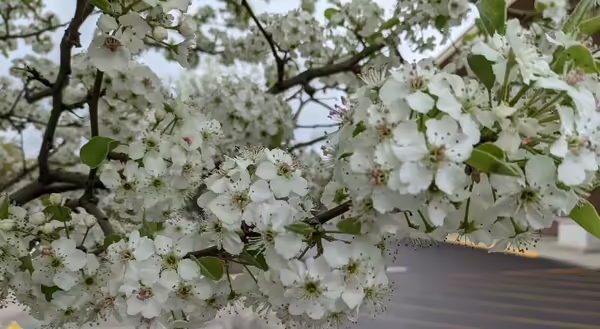
Spring has sprung! Birds are active, insects are emerging, and the early bloomers are starting to show their bright flowers indicating the cold days of winter are almost behind us. You may notice the brilliant displays of blooming trees, particularly a white one, that feels like it is THE tree for parkways and parking lots. Unfortunately, this stunning spring bloomer is not only found in its intended location, but also in natural areas across Illinois. That tree is the Callery pear which is sometimes referred to as the Bradford pear.
Site volunteers at Orland Grasslands, a grassland in the Calumet Region of Cook County, started to notice the Callery pear (Pyrus calleryana) three years ago. At first, they noticed isolated sprigs that went about largely undetected among the tall grass. A few seasons later, it had become a problem over dozens of acres, crowding out native species and creating dense thickets. Once ecologists for the Forest Preserves of Cook County conducted surveys, this species was discovered everywhere on the 750-acre site. When searching for a source, land managers discovered that it was a popular shrub planted in the adjacent village Orland Park. The site stewards and local volunteers approached village leadership about this issue. Now the tree is no longer planted for new public installation of parks, parkways, and greenspaces, a major win for the grasslands. Additionally, it is also being phased out as part of their tree preservation program, allowing for sick Callery pears to be removed and replaced by a native alternative.
The Callery pear is a cultivar that has been bred to endure the urban landscape of disturbance. And its popularity makes a lot of sense, it is quick growing and has a brilliant spring display. The story of the pear and Orland Grassland is extremely common among natural areas as this tree is commonly the go to parkway tree for new neighborhood developments. The tree is also sold at big box stores, therefore, can be an easy choice for homeowners looking to have a beautiful flowering tree that will show returns quickly. Although originally bred to be self-sterile (cannot receive pollen from other trees of the same cultivar), it can cross-pollinate with other non-sterile Callery pears and produce seed that is spread by birds and other wildlife. These traits cause this tree to be a major problem in natural areas undergoing active restoration.
However, just like Orland Park, community members can use this knowledge to help protect natural areas from the spread of this invasive by choosing native alternatives and sharing this information with their neighbors and community leaders. Although Orland Grasslands is still fighting the Callery pear, land managers can feel assured that new introductions of this invasive are not coming from the adjacent town.
Learn More about the Callery pear
- Callery pear from the Morton Arboretum
- A certain air around Callery Pear from Illinois Extension
- The Harsh Reality for the Bradford Pear from Illinois Extension
- Illinois Extension’s Invasive Species Website
MEET THE AUTHOR: Abigail Garofalo is a Natural Resources, Environment, & Energy Educator for Cook County. She manages the Cook County Master Naturalist program and the Conservation@Home program for University of Illinois Extension. She has a BS in Natural Resources and Environmental Sciences and MS in Agricultural Leadership Education both from University of Illinois Urbana Champaign. Her background in is environmental outreach and interpretation and works to create a culture of environmentalism through community building.
ABOUT THE BLOG: Naturalist News is a blog by University of Illinois Extension Master Naturalist staff and volunteers who bring you stories highlighting the individuals, places, wildlife, and plants that make this state amazing. Join us each week to learn something new, be inspired and become connected to your own community by recognizing the amazing ways we are all intertwined. Want to get notified when new Naturalist News posts are available? Sign up here!